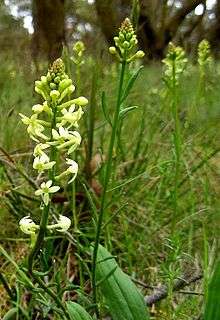Stackhousia monogyna
| Stackhousia monogyna | |
|---|---|
 | |
| Scientific classification | |
| Kingdom: | Plantae |
| (unranked): | Angiosperms |
| (unranked): | Eudicots |
| (unranked): | Rosids |
| Order: | Celastrales |
| Family: | Celastraceae |
| Genus: | Stackhousia |
| Species: | S. monogyna |
| Binomial name | |
| Stackhousia monogyna Labill.[1] | |
| Synonyms | |
| |
Stackhousia monogyna, commonly known as creamy stackhousia or creamy candles, is a perennial herb species in the family Celastraceae. It is native to Australia. Plants grow to 70 cm (28 in) high and produce a terminal spike of white, cream or yellow flowers between August and January in the species native range.[1][2]
The species was first formally described in 1805 by French naturalist Jacques Labillardière in Novae Hollandiae Plantarum Specimen. His description was based on plant material collected in Tasmania.[1]
References
- 1 2 3 "Stackhousia monogyna". Australian Plant Name Index (APNI), IBIS database. Centre for Plant Biodiversity Research, Australian Government, Canberra. Retrieved 3 April 2011.
- ↑ "Stackhousia monogyna". PlantNET - New South Wales Flora Online. Royal Botanic Gardens & Domain Trust, Sydney Australia. Retrieved 3 April 2011.
This article is issued from Wikipedia - version of the 4/27/2016. The text is available under the Creative Commons Attribution/Share Alike but additional terms may apply for the media files.